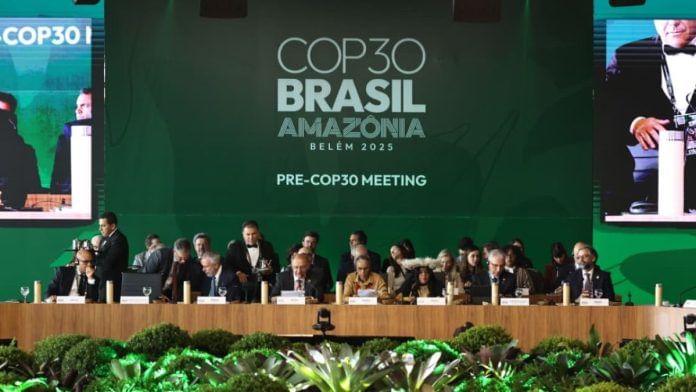As the world moves toward COP30 and India assumes a larger voice in shaping global climate finance, the question confronting policymakers is no longer whether to act, but how to pay for it. Emerging markets like India face a cruel paradox: they must invest trillions in green infrastructure to meet net-zero commitments, even as public debt stands at historic highs and fiscal space shrinks.
Despite repeated promises, the global architecture of climate finance remains linear, fragmented, and inadequate. Governments borrow, multilateral banks lend, and the private sector joins sporadically when returns look safe. The result is a cycle of dependence, not regeneration. What we need now is not just more money, but a smarter way to make money move.
That is the idea behind circular finance — an approach I have argued for in both government and policy debates — one that can make climate action fiscally sustainable.
What circular finance means
In conventional finance, capital flows in one direction: from source to asset to repayment. Once a project is built, money is locked up until the debt is serviced or investors exit. Circular finance breaks that one-way street.
It treats capital as regenerative — flowing continuously between public and private sources, across debt and equity, and through multiple project stages. Capital doesn’t sit idle; it keeps circulating. When projects mature, their revenue streams can be monetised through mechanisms like Infrastructure Investment Trusts (InvITs), freeing up public capital for redeployment. The same rupee, in effect, builds twice.
This circularity of finance can turn today’s infrastructure bottleneck into a flywheel of investment — compounding capital efficiency while reducing debt pressures.
The problem with linear finance
Traditional public–private partnerships (PPPs) were meant to bridge the gap between limited public budgets and private investment. But most PPPs in India and elsewhere have been static, rigid, and risk-averse. Governments end up carrying contingent liabilities while private players retreat at the first sign of volatility.
Circular finance can repair that broken model. It transforms PPPs from one-time collaborations into continuous investment cycles. Public money acts as seed capital that crowds in private funds, while mature projects are sold to long-term investors such as pension and insurance funds. This rotation ensures that fresh projects can be financed without burdening public accounts.
India’s hybrid annuity PPPs, coupled with InvIT structures, already show how this can work. The public sector builds and stabilises assets; private and institutional investors take over once revenue streams are secure. It is a model of continuity — one that aligns fiscal prudence with climate ambition.
Also read: One Nation, One Development model won’t work for Lakshadweep, Sunderbans, says Jairam Ramesh
The global shift India can lead
Elsewhere, countries like Brazil, South Africa, and Indonesia are experimenting with similar ideas. Their blended-finance platforms and Just Energy Transition Partnerships (JETPs) are early attempts at capital recycling. But the real transformation must come from the multilateral system.
Despite the rhetoric, multilateral development banks (MDBs), like the World Bank and the Asian Development Bank, still operate as lenders, not market-makers. Their risk frameworks and capital adequacy norms constrain the very mobilisation they are tasked to achieve. Circular finance provides a template for reform: MDBs should use guarantees, first-loss tranches, and securitisation to attract institutional investors to climate infrastructure.
The 2023 G20 Triple Agenda report has already called for a redesign of MDB mandates. India, which played a central role in that conversation, is ideally positioned to champion the operational model — not just the philosophy — of circular finance.
Debt and climate
One reason climate finance remains stuck is that it is treated apart from fiscal policy. Yet, the two are inseparable. If the cost of decarbonisation pushes debt ratios to unsustainable levels, the transition will stall politically and economically. Circular finance resolves this tension by ensuring that every rupee of public expenditure catalyses multiple rounds of private participation. It builds a feedback loop that multiplies impact without multiplying debt.
Also read: Climate action plans aren’t one-size-fits-all. What suits Mumbai won’t suit Bengaluru
The road ahead
India has already laid some of the groundwork. The InvITs, the National Investment and Infrastructure Fund (NIIF), and the National Monetisation Pipeline (NMP) embody the logic of recycling capital. The next step is to extend these mechanisms to green sectors — renewable energy, green hydrogen, sustainable mobility, and waste management — and to link them with international carbon and climate funds.
Circular finance is more than a financial mechanism; it is a way of reimagining the relationship between the state, markets, and sustainability. It turns climate finance from a one-time transfer into a living, circulating system.
As the world confronts the twin crises of climate and debt, India can lead with both conviction and creativity. By making finance circular, we can make climate ambition both affordable and enduring.
The author is a former finance secretary to the Government of India and chairman, Institute of Development Studies Jaipur. Views are personal.
(Edited by Aamaan Alam Khan)






